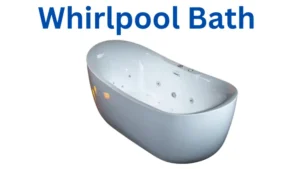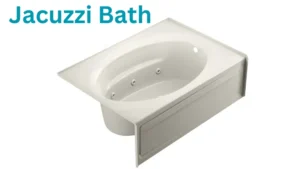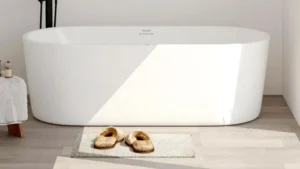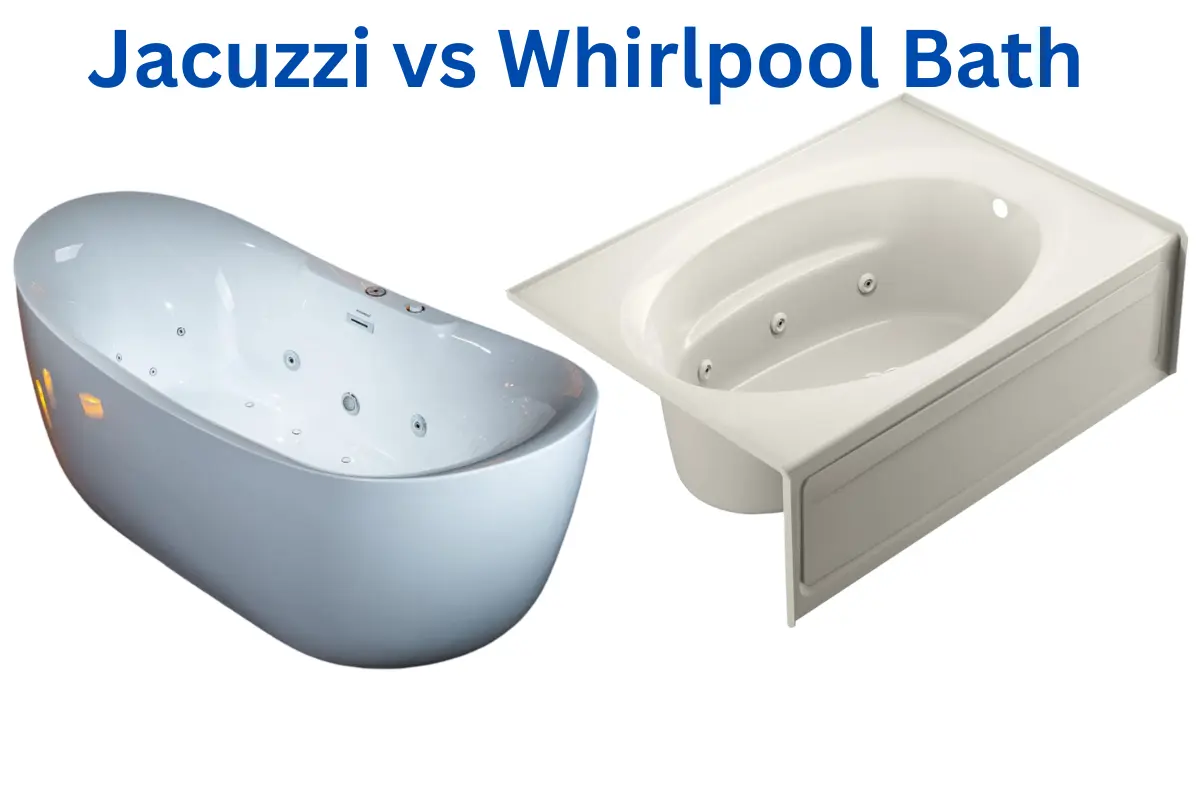A Jacuzzi vs whirlpool bath both promise relaxation and luxury. They seem similar, yet differences exist.
You can think after a long day, you’re ready to unwind in a bath. But which type should you choose, a Jacuzzi or a whirlpool bath? Both offer a spa-like experience at home, with high-pressure jets that massage tired muscles and promote relaxation.
However, choosing between them can be as tricky as selecting your favorite dessert at a lavish banquet. This comparison is not just about the feel-good factor; it’s about understanding the features, benefits, and overall experience that each option brings to your bathroom.
We’ll dive into the heart of the matter, exploring how these indulgent baths can transform your daily routine into a rejuvenating escape. So get ready to soak in the details and find out which bath best bubbles up to your personal preference and lifestyle.
Jacuzzi vs Whirlpool Bath Both Features
Jacuzzi Features
Choosing between a Jacuzzi vs whirlpool bath can be tough. Both offer a relaxing soak, but they have different features. Let’s dive into what makes Jacuzzis stand out. We will explore their history, types, and health benefits. Understanding these can help you make a better choice for your home.
History Of Jacuzzi
The Jacuzzi story began in the early 20th century. It was created by the Jacuzzi brothers, immigrants from Italy. Originally, they made air pumps for airplanes. But, their focus shifted after they invented a hydrotherapy pump. This was to help a family member with arthritis. The first Jacuzzi tub was sold in 1968. It combined water and air for a relaxing experience.
Let’s break down key milestones:
- 1920s: Jacuzzi brothers start their business.
- 1950s: Invention of the hydrotherapy pump.
- 1960s: First Jacuzzi tub sold.
This table shows the evolution:
| Year | Event |
|---|---|
| 1920 | Business start |
| 1950 | Hydrotherapy pump invention |
| 1968 | First Jacuzzi tub sold |
Types Of Jacuzzis
Jacuzzis come in various shapes and sizes. They fit different spaces and needs. Here are the main types:
- Indoor Jacuzzis: Great for private, year-round use.
- Outdoor Jacuzzis: Perfect for enjoying the outdoors.
- Portable Jacuzzis: Move them as needed.
Each type has unique features. Indoor models can be part of your bathroom. Outdoor ones add fun to your backyard. Portable versions are flexible. Choose based on where and how you’ll use it.

Health Benefits
Jacuzzis are not just for luxury. They offer health benefits. Warm water and massage jets can relax muscles and ease pain. Here are some benefits:
- Stress relief: Soaking in a Jacuzzi can reduce stress.
- Improved sleep: The warm water can help you sleep better.
- Muscle relaxation: Jets massage muscles, easing tension.
- Improved circulation: Warm water boosts blood flow.
Regular use can lead to these health improvements. It’s a simple way to care for your body and mind.
Whirlpool Bath Basics
Delving into the world of at-home luxury, the terms ‘Jacuzzi’ and ‘Whirlpool Bath’ often emerge as leading contenders for those seeking indulgent relaxation. Understanding the essentials of a whirlpool bath sets the stage for an informed choice between these two soothing experiences. Let’s immerse ourselves into the whirlpool bath basics to discover what makes these baths a delightful addition to any home.
What Is A Whirlpool Bath?
A whirlpool bath, commonly mistaken as synonymous with a Jacuzzi, is actually a blanket term for any tub with jet streams that circulate water. These baths are designed to offer a massage-like experience through jets strategically positioned to target various areas of the body. Key features include:
- Multiple Water Jets: Positioned to provide a full-body massage.
- Water Circulation: Ensures consistent water movement.
- Adjustable Settings: Allows control over jet intensity.
Whirlpool baths come in various shapes and sizes, each offering a unique set of benefits. A table comparing different whirlpool bath types might look like this:
| Type of Whirlpool Bath | Features | Best for |
|---|---|---|
| Drop-in | Customizable, Various Shapes | Larger Bathrooms |
| Corner | Space-saving, Multi-person Use | Small Bathrooms |
| Freestanding | Stylish, Centerpiece Tub | Spacious, Modern Bathrooms |
Design And Functionality
Whirlpool baths are engineered not just for comfort but also for visual appeal and practical functionality. Design-wise, they can range from sleek, modern lines to more classic shapes, often with ergonomic features like molded armrests and contoured backrests. Functionally, they are equipped with:
- High-performance Water Jets: For targeted massage.
- Inline Heater: Keeps the water temperature consistent.
- Easy-to-Clean Surfaces: To maintain hygiene.
These elements come together to create a bath that not only enhances the aesthetics of a bathroom but also provides a user-centric experience focused on relaxation and health benefits.
Therapeutic Uses
The therapeutic uses of whirlpool baths are vast, with many individuals turning to them for relief from various ailments. The combination of warm water and massage jets can:
- Relieve Muscle Tension: Loosening tight muscles.
- Improve Circulation: With stimulating water movement.
- Reduce Stress: By promoting relaxation.
For those with chronic conditions such as arthritis or fibromyalgia, regular sessions in a whirlpool bath may help in managing pain and enhancing mobility. The soothing effect of the water jets can also aid in better sleep patterns and overall wellbeing.
Jacuzzi Vs Whirlpool Bath Pros And Cons
When comparing Jacuzzi to whirlpool baths, it’s crucial to weigh their pros and cons. Here’s a concise breakdown:
| Jacuzzi | Whirlpool Bath | |
|---|---|---|
| Pros | Brand recognition, Patented technology | Versatile options, Customizable settings |
| Cons | Often more expensive, May have higher upkeep costs | May require professional installation, Can be noisy |
Ultimately, the choice between a Jacuzzi and a whirlpool bath depends on personal preferences, budget, and the specific benefits one is looking for in a home spa experience.

Key Differences
When diving into the relaxing world of at-home spa experiences, you may find yourself weighing the options between a Jacuzzi and a Whirlpool bath. Both offer a blissful soak, but they are not the same. Understanding the key differences can help you make an informed decision tailored to your personal relaxation needs. Let’s delve into the mechanics, water circulation, and jet configurations that set these two hydrotherapy giants apart.
Mechanics Of Operation
The mechanics behind Jacuzzi and Whirlpool baths are designed to create soothing experiences, but they operate differently. A Jacuzzi, often used as a brand name but also to refer to hot tubs in general, typically features a built-in heating system to keep the water warm. Whirlpool baths, on the other hand, focus on the movement of water rather than maintaining a specific temperature.
Here’s a breakdown of how each system works:
- Jacuzzi: Heats water and uses air jets to push the water through the system.
- Whirlpool Bath: Recirculates water through jets, creating a massage-like effect without necessarily heating the water.
These differing approaches mean that a Jacuzzi can offer a consistently warm experience ideal for relaxation and hydrotherapy, while Whirlpool baths provide a more vigorous water massage, perfect for targeting sore muscles. The choice depends on whether you prioritize heat or massage in your soaking sessions.
Water Circulation Methods
Water circulation is at the heart of any hydrotherapy experience. Both Jacuzzi and Whirlpool baths circulate water, but they do so in distinct ways that affect the overall experience.
| Jacuzzi | Whirlpool Bath |
|---|---|
| Utilizes air jets to create bubbles and a gentle massaging action. The air is mixed with water to circulate it in the tub. | Employs water jets to pull water from the bath and forcefully expel it back into the tub, creating a strong, targeted water flow. |
The choice between these two methods can influence the type of relief you’re looking for. If you prefer a gentle, bubbling soak, a Jacuzzi might be your best bet. For a more intense massage, the water jets in a Whirlpool bath can provide a deeper touch to help relieve tight muscles.
Jet Configurations
Jet configurations play a crucial role in the quality of your bath experience. Both Jacuzzi and Whirlpool baths have different jet setups which can impact the sensation and effectiveness of the bath. Let’s explore:
- Jacuzzi: Typically has more air jets, which produce thousands of tiny bubbles for a soft tissue massage.
- Whirlpool Bath: Often features fewer, but more powerful, water jets strategically placed for deep tissue massage and targeted relief.
The arrangement and number of jets determine the type of hydrotherapy each bath can offer. Jacuzzis with their air jet systems are better suited for a light, full-body caress, while Whirlpool baths with their water jets provide more intense, localized pressure. This distinction is key when deciding which bath experience will best suit your relaxation and therapeutic needs.
Installation Process
Choosing between a Jacuzzi and a whirlpool bath brings its own set of challenges, but the installation process is often the deciding factor. Both options promise a spa-like experience, but their installation demands careful planning and understanding. Let’s dive into the specifics to ensure your bathroom upgrade goes smoothly.
Space Requirements
Before you even think about soaking in those blissful bubbles, you need to measure up. Both Jacuzzi and whirlpool baths need enough room not just for the unit but also for maintenance access. Here’s a quick checklist to help you gauge if your space is ready:
- Measure your bathroom: Ensure the dimensions fit the bath’s requirements.
- Consider access points: Can you get the bath through the door?
- Service access: Leave space for repairs without needing to tear down walls.
It’s not just about fitting the tub in the space, but also about the room you’ll need around it. Think about getting in and out safely. The table below outlines the minimum space required for installation:
| Bath Type | Length | Width | Height | Additional Space |
|---|---|---|---|---|
| Jacuzzi | 5 feet | 2.5 feet | 2 feet | 1 foot around perimeter |
| Whirlpool Bath | 5 feet | 2.5 feet | 2 feet | 1 foot around perimeter |
Plumbing Considerations
Plumbing is key to a successful installation. Both Jacuzzi and whirlpool baths have complex systems that need professional hands. Your checklist should include:
- Water supply: Ensure your system can fill the bath quickly.
- Drainage: A powerful drain is essential to avoid flooding.
- Pumps and jets: These need connections to water lines.
It’s vital to get a licensed plumber on board. They will check water pressure, drainage routes, and the feasibility of installing additional pipes. Remember, improper plumbing not only risks leaks but can also void warranties.
Electrical Needs
Electricity brings your bath’s features to life but demands respect and precision. Both Jacuzzi and whirlpool tubs will need:
- Dedicated circuits: Prevents tripping of breakers.
- Ground Fault Circuit Interrupter (GFCI): A must for safety in wet areas.
- Proximity to power sources: Cords and wires should be within reach but safe from water.
Like plumbing, electrical work is not a DIY task. A certified electrician can ensure that all elements comply with local codes. They will set up the necessary circuits and ensure everything is up to standard, keeping you safe from electrical hazards.
Maintenance Tips
Choosing between a Jacuzzi and a whirlpool bath is just the start. Keeping them clean and working well is key. Here are easy tips to help with that.
Cleaning Techniques
Keeping your Jacuzzi or whirlpool bath clean does not have to be hard. Follow these simple steps:
- Use the right cleaner: Pick a cleaner made for Jacuzzis or whirlpool baths. This keeps them safe.
- Regular cleaning: Clean it often to stop dirt from building up.
- Rinse well: After cleaning, rinse it well. This makes sure no cleaner is left behind.
Also, remember to clean the filters. Dirty filters can make the water dirty. Here’s how:
- Turn off the bath.
- Remove the filter.
- Clean it with water and a soft brush.
- Put it back when dry.
Doing these steps keeps your bath clean and safe to use.
Water Treatment
Good water quality makes your bath more enjoyable. Here’s how to keep the water nice:
- Use water treatments: They keep the water clean and clear.
- Change the water: Do this often to keep it fresh.
Test the water too. You can use test strips. They show if you need more treatment. Aim for:
| pH Level | 7.4 to 7.6 |
|---|---|
| Chlorine | 1.0 to 3.0 ppm |
Keeping the water in this range makes sure it’s safe and feels nice.
Common Repairs
Sometimes, things break. But many repairs are simple. Here are common ones:
- Leaks: Tighten connections or replace seals to stop leaks.
- Not heating: This might be a broken heater or thermostat. You might need a pro to fix this.
- Noisy pump: If it’s loud, it might be clogged or need replacing.
Always turn off the power before fixing anything. This keeps you safe. If you’re not sure, get a professional. They know how to fix it safely.
With these tips, you can keep your Jacuzzi or whirlpool bath in good shape. This means you can enjoy it more and worry less.

Cost Comparisons
Deciding between a Jacuzzi and a whirlpool bath for your home is a big decision that affects both comfort and wallet. Let’s dive into the costs of each option. Understanding these differences can help you make a smart choice that fits your budget and lifestyle.
Initial Purchase Price
The upfront cost is a major factor when choosing between a Jacuzzi and a whirlpool bath. Here’s what you need to consider:
- Jacuzzi: Often seen as a premium option because of the brand name, Jacuzzis can be more expensive.
- Whirlpool Bath: Typically, these baths are less costly compared to brand-name Jacuzzis but offer similar features.
The price can vary widely based on size, features, and materials. On average, a standard whirlpool bath can start around $1,000, while a Jacuzzi might start at $2,000. Remember, prices can climb significantly for luxury models.
Installation Expenses
Installation costs should not be overlooked. They can differ greatly based on your bathroom’s current setup and the complexity of the installation. Here’s a quick breakdown:
| Feature | Jacuzzi | Whirlpool Bath |
|---|---|---|
| Plumbing | $500-$1,500 | $500-$1,000 |
| Electrical | $100-$500 | $100-$500 |
| Structural | $200-$1,000 | $200-$800 |
Keep in mind these are rough estimates. Your actual costs might be higher or lower. Professional installation is key for safety and warranty purposes.
Long-term Maintenance Costs
Long-term maintenance is a cost that can sneak up on you. Here’s what to expect:
- Jacuzzi: Might need specialized parts or service due to the brand name, which can add up over time.
- Whirlpool Bath: Generally has more generic parts, potentially reducing long-term costs.
Both will require regular cleaning and occasional repairs. Budget for ongoing expenses like water treatment and energy costs, which can range from $20 to $30 a month.
Hot Tub Vs Jacuzzi Cost
People often use ‘hot tub’ and ‘Jacuzzi’ interchangeably, but they can differ in cost:
- Hot Tub: Usually refers to any brand of outdoor tub with jets, potentially less expensive than a Jacuzzi.
- Jacuzzi: A specific brand name, often priced higher due to its market reputation.
Outdoor hot tubs might need additional investments like decking and covers. A basic hot tub can start around $2,500, whereas a Jacuzzi brand hot tub might start at $4,000 and go up from there.
User Experience
Choosing between a jacuzzi and a whirlpool bath is more than just picking a bathroom fixture. It’s about the experience they offer. Both promise to transform your bathing routine into a spa-like retreat, but their user experiences differ. Comfort, noise, and aesthetics play crucial roles in your daily soak. Let’s dive into these aspects to help you decide which bath best suits your relaxation needs.
Comfort Levels
When it comes to comfort, both jacuzzi and whirlpool baths have their perks. Jacuzzis are known for their luxurious feel, often featuring ergonomically designed seating with targeted jet placements. Whirlpool baths, on the other hand, offer a deep tissue massage effect through powerful water jets.
Here are some comfort considerations:
- Seating: Jacuzzis typically come with built-in seats, while whirlpool baths may not.
- Jet Placement: The strategic placement of jets can target sore muscles effectively.
- Water Temperature: Both allow control over water temperature for ultimate relaxation.
Users often report that the type of bath chosen can impact their comfort levels differently. For instance:
| Jacuzzi | Whirlpool Bath |
|---|---|
| Contoured seating for full-body support | Open space for flexibility in movement |
| Multiple jet systems for a gentle experience | High-pressure jets for intense massage |
Noise Considerations
Noise can be a deal-breaker for some when choosing the perfect bath. Jacuzzis tend to produce a gentle hum due to their air jet system. Whirlpool baths generate more noise as water jets pump at high velocity. The noise levels can influence the relaxation experience. Quiet baths allow for a serene environment, while louder baths might disrupt the peace. Consider the following:
- Motor Quality: Higher-quality motors in whirlpool baths can reduce noise.
- Insulation: Some models come with sound-dampening features to minimize noise.
Users often notice the sound difference during their soak:
| Jacuzzi | Whirlpool Bath |
|---|---|
| Lower noise levels for a calm soak | Potentially louder, depending on jet intensity |
Aesthetics
The look of your bath can affect your mood and the overall design of your bathroom. Jacuzzis often boast a modern and sleek design, becoming the focal point in a bathroom. Whirlpool baths are more traditional but offer a variety of styles to match different decor preferences. Let’s break down the aesthetic appeal:
- Design Variety: Both come in different shapes and sizes to complement your space.
- Material Finish: Options like acrylic and fiberglass provide a clean, inviting look.
The visual impact of each bath type is notable:
| Jacuzzi | Whirlpool Bath |
|---|---|
| Contemporary designs that stand out | Classic styles that blend in |
Your choice will shape the ambiance of your bathroom sanctuary.
Choosing The Right one of Jacuzzi vs Whirlpool Bath
Deciding between a Jacuzzi and a whirlpool bath is not just about choosing a bathroom fixture. It’s about picking a lifestyle. Both options offer a luxurious way to unwind, but they cater to different needs and preferences. Understanding these differences is key to making the right choice for you and your home.
Lifestyle Fit
When thinking about a Jacuzzi or whirlpool bath, consider your lifestyle. Do you seek relaxation after a long day or physical therapy for sore muscles? Jacuzzis, with their air jets, provide a gentle massage perfect for relaxation. Whirlpool baths, on the other hand, use water jets for a more intense massage, aiding in muscle recovery.
- Jacuzzi: Best for relaxation and light massage.
- Whirlpool Bath: Ideal for deep tissue massage and muscle recovery.
Also, think about maintenance. Whirlpool baths may require more cleaning due to the water jets. Here is a quick comparison:
| Feature | Jacuzzi | Whirlpool Bath |
|---|---|---|
| Maintenance | Lower | Higher |
| Massage Type | Light | Intense |
Budget Considerations
Your budget plays a crucial role in your decision. Generally, whirlpool baths cost less than Jacuzzis. But, initial cost is not everything. Consider long-term costs too. Jacuzzis might have higher upfront costs but lower maintenance costs. Here’s a simple breakdown:
- Initial Cost: Whirlpool baths are usually cheaper.
- Maintenance Cost: Jacuzzis tend to have lower maintenance costs.
Remember, investing in quality now can save money later. Cheaper models might need more repairs. Think about energy use too. Whirlpool baths might use more energy, increasing your bills.
Space Availability
Space in your bathroom dictates your choice too. Jacuzzis usually need more space than whirlpool baths. Measure your bathroom before deciding. Here’s why space matters:
- Jacuzzis: Need more room for air jet systems.
- Whirlpool Baths: Can fit into smaller spaces.
Also, consider the bath’s shape and size. Some models might fit better in your space. Planning is key. Here’s a tip: draw a bathroom layout to see what fits best.
Choosing between a Jacuzzi and whirlpool bath depends on lifestyle, budget, and space. Each option offers unique benefits. Think about what matters most to you. This way, you’ll find the perfect fit for your home.
FAQs about Jacuzzi vs Whirlpool Bath
Which is better, a bath tub or a Jacuzzi?
A Jacuzzi is better for relaxation and hydrotherapy, while a bathtub is more practical for quick baths and easier to maintain. Your choice depends on your priorities: comfort versus convenience.
What are the disadvantages of Jacuzzi bathtub?
Disadvantages of a Jacuzzi bathtub include:
- Maintenance: Requires regular cleaning and upkeep of jets and plumbing.
- Space: Needs more room than a standard bathtub.
- Cost: Generally more expensive to purchase and install.
- Energy Use: May increase utility bills due to heating and pump operation.
- Complexity: Installation can be more complicated, requiring professional help.
What is the difference between a hot tub and a jetted tub?
The main difference between a hot tub and a jetted tub is their design and purpose:
- Hot Tub: Typically a standalone outdoor or indoor unit designed primarily for relaxation, featuring built-in jets, heating, and seating for multiple people.
- Jetted Tub: Usually a bathtub with jets, designed for indoor use, providing a spa-like experience in a more traditional bath setting. It’s meant for individual use and can be installed in a bathroom.
Hot tubs are larger and more social, while jetted tubs focus on individual hydrotherapy.
What is a whirlpool bath called?
A whirlpool bath is often called a jetted tub or spa tub. It features jets that provide hydrotherapy and massage effects.
Conclusion
Deciding between a jacuzzi and a whirlpool bath depends on your needs. Both offer relaxing experiences, but they cater to different preferences. Jacuzzis provide an outdoor social setting. Whirlpool baths are great for private indoor relaxation. Consider space, budget, and desired features before making a choice.
Remember to think about upkeep too. Both need regular cleaning, but the joy of unwinding in warm bubbles makes it worth it. Your perfect home spa awaits – choose what suits you best and enjoy the soothing benefits. Relax, recharge, and let the stress melt away.

